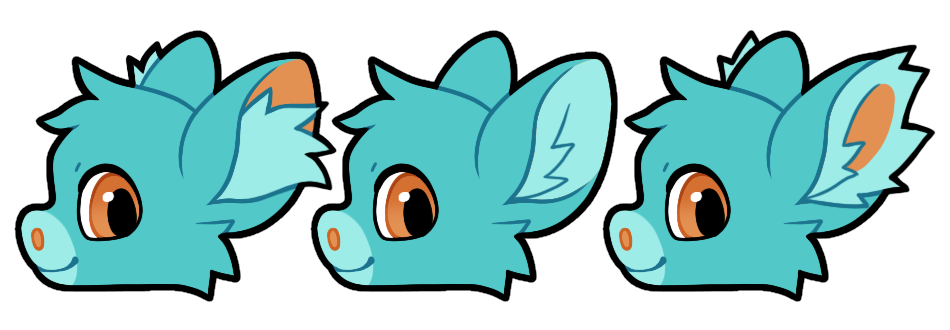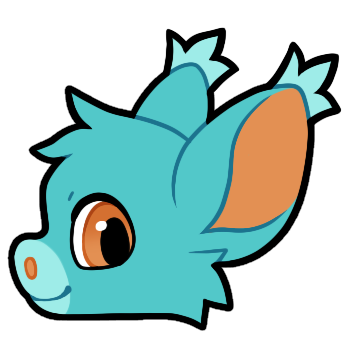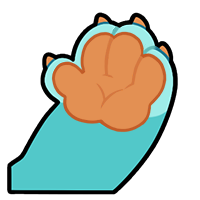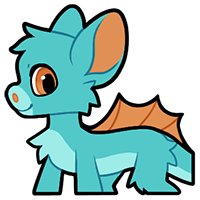Traits
Dark Sclera (Notable)
In some animals the protective layer on their eyes is a darker color, possibly even black in appearance. This adaptation is theorized to hide eye movements in predators or even act as 'gaze camouflage' for social species hiding where they may be looking from others around!
Hollow Eyes (Hollow)
Life in a world of little-to-no light can present several obstacles, arguably the most important being how to sense the enviroment. Hollow Xeros have developed eyes that feature significantly larger pupils and a highly efficient tapetum. These features enable them to operate effectively in the darkest of conditions and give their eyes a soft, reflective sheen.
Slit Pupils (Standard)
Some Xeros may have thin, slit pupils instead of the standard round or oval ones. This is an uncommon adaptation, but the Xeros that have this style of eye tend to have even stronger night vision.
Bright Pupils (Notable)
In some Xeros, the tapetum lucidum that gives them such excellent low-light vision undergoes a dramatic mutation. Bright pupils are the result of this highly reflective tissue, causing it to reflect in such a manner to create this striking appearance! This trait allows a Xero's pupils to be lighter in color than the iris (the main colored part of the eye). The bright pupils can be any color, so long as they are lighter in value than the iris.
Shaped Pupils (Glitched)
While Xeros typically feature a static pupil, their flexible biology can be manipulated to overcome this limitation. By altering the smooth muscles of the eye, the collarette can be reshaped effectively, changing the shape until desired.
Horizontal Pupils (Seasonal)
Though it's very rare, some Xeros may have horizontal pupils instead of the standard round or oval ones. This strange adaptation gives the Xero a wider field of view, making them very hard to sneak up on.
Eye Stalks (Glitched)
Eye stalks are classified as two protrusions from the head of a Xero that have a cone-like base and two round eyes on top. These stalk eyes are simple ocelli and are primarily used to detect light, dark, and movement all around the Xero, rather than complex shapes or colors. Sneaking up on a Xero with this trait would be very difficult!
Eye stalks must be placed on top of the Xero's head area and must be in pairs, much like adding any other extra body part. The eyes must also match the iris and pupil color of the rest of the eyes on the Xero, meaning that if a Xero has blue irises, the stalks must follow suit!
How To Use This Trait
 Do
Do
-
This trait must be placed on the Xeros head area and cannot be placed anywhere else.
-
Much like any extra body parts, eye stalks must be placed in pairs.
-
Eye stalks can be added 2x with Glitch Vials for a maximum of 4 eye stalks.
-
Eye stalks count as extra eyes, and any Xero that has more than 4 eyes total may be censored on the Masterlist. For example a Xero with 4 main eyes and 2 eye stalks would have 6 eyes total, or a Xero with 2 main eyes and 4 stalk eyes.
-
The eye stalks must match the iris and pupil color of the other eyes on the Xero.
-
Eye mutations such as slit pupils may be present on the other eyes of the body but do not need to be added to the stalked eyes.
-
If your Xero has an eye mutation it is no extra cost to add it to your eye stalks.
 Don't
Don't
-
The eye stalks must be placed close together in pairs much like a snail's eyes, placing one "hidden" while the other is prominent is not allowed.
-
The eyes on the top of the eye stalks are small and form on top of the base cones, huge eyes that weigh down the base cones would not be allowed.
-
Eye stalks do not have eyelids.
-
Eye mutations such as Hollow Eyes or Slit Pupils cannot be added ONLY to the Eye Stalks without also being added to the rest of the eyes on the Xero.
This trait can only be added by using a Glitch Vial on a Xero that has the "Glitched" status.
Click the magnifying glass above for examples of this trait! 🔍
Hollow Ears (Hollow)
These ears are unique to Hollow Xeros, and while they fit the shapes and sizes you expect from a standard Xero, they do have an adaptation unique to their type. The ear's interior cartilage is ridged, acting as a type of acoustic focusing lens to help sharpen sounds for positional accuracy in the dark. Hollow ears can be a solid color, or have a gradient of changing colors within the different segments. The ridges within the ear must be present.
Frilled Ears (Seasonal)
Frilled Ears are a rare mutation observed on Xeros. They have a grooved outer edge, giving them a jagged or wing-like appearance.
Desert Ears (Desert)
Desert Xeros can have larger than average ears to radiate heat, this trait is known as Desert Ears. They can be any shape (pointy fennec-like, rounded jackrabbit-like, etc.) Size can vary a bit, but is generally about 1.5 to 2x the height of the head.
Tundra Ears (Tundra)
Tundra Xeros can have extremely fluffy ears called Tundra Ears; the fluff is so long that the tufts of fur inside cover most or all of the visible skin and hangs outside the ears!
How To Use This Trait

 DO: Tundra Ears can include very long tufts of fur inside the ears that covers most of the visible skin, all of the visible skin, sticks outside the ears, or forms a ring of fur around the skin of the inner ear.
DO: Tundra Ears can include very long tufts of fur inside the ears that covers most of the visible skin, all of the visible skin, sticks outside the ears, or forms a ring of fur around the skin of the inner ear.
 DO NOT: Xeros without the Tundra Ear trait should not have overly fluffy ear insides. A very small tuft of fur as an accent is allowed, but it cannot take up too much space inside the ear or poke outside the ear at all. Xeros without the Tundra Ear trait should also not have overly fluffy ear outsides, with the exception of the Tufted Ear trait allowing the Xero to have fluffy ear tips.
DO NOT: Xeros without the Tundra Ear trait should not have overly fluffy ear insides. A very small tuft of fur as an accent is allowed, but it cannot take up too much space inside the ear or poke outside the ear at all. Xeros without the Tundra Ear trait should also not have overly fluffy ear outsides, with the exception of the Tufted Ear trait allowing the Xero to have fluffy ear tips.
This trait can only be added to Tundra Xeros or Xeros that have the "Glitched" status by using a Tundra Vial.
Click the magnifying glass above for examples of this trait! 🔍
Folded Ears (Unusual)
Folded Ears are a common mutation observed on Xeros. These ears can be various shapes and sizes depending on other mutations present, but feature ears that are bent or folded in some way.
Tufted Ears (Standard)
Tufted Ears are a common mutation observed on Xeros. These ears can be any shape or size, but feature tufts of longer fur at the tips. This adaptation may have allowed Xeros to more easily determine wind direction and stay downwind of danger.
How To Use This Trait
✅ Do

🚫 Don't

This trait can be added to your Xero by giving them a Kara Berry.
Lop Ears (Unusual)
Lop Ears are an uncommon mutation observed on Xeros. Xeros with these ears lack structural cartilage and muscle control, leading to fully hanging ears like the ears of a lop rabbit.
Round Ears (Unusual)
Round Ears are a unusual mutation observed on Xeros. These ears are very circular in shape, rather than the elongated, diamond-like shape Xero ears typically are.
Marine Ears (Marine)
Marine Xeros can have extra small ears, or no visible ear flaps at all. This adaptation helps them be more streamlined underwater. If combined with the Marine Fin trait, they can have fins instead of ears!
Woodland Pads (Woodland)
Flat pads that cover the entire palm and sole of their paws allow Woodland Xeros to grip onto bark and foliage with ease while climbing, allowing them to get to higher elevations quicker. These pads are covered in the same setae as standard Xero paws, but the higher coverage gives them enhanced grip.



















